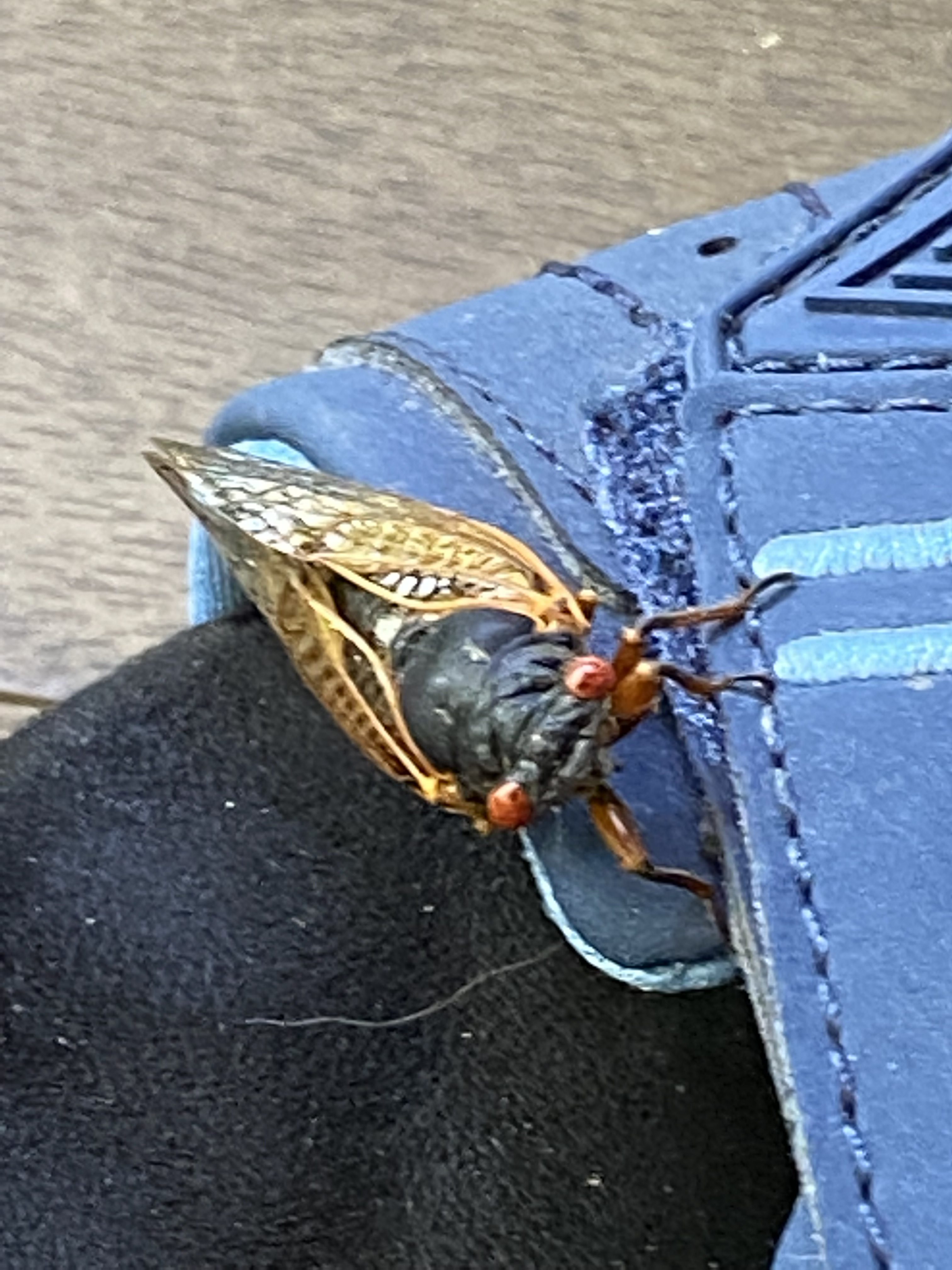Wassup? – 17 year Brood X Cicada – Photo: L. Weikel
Stuff of Nightmares
I don’t know about you, but I’m missing the whirring purr of the Brood X 17-year cicadas that emerged from the ground in droves this past May. As of today, I didn’t hear the distinctive call of a single periodical cicada. The silence made me sad. As I’ve said before, the whirr emitted from the males’ tympanae mesmerized me. And the occasional <clang clang clang> reminiscent of one of those wind up stuffed monkeys with cymbals would interject unexpected color to the otherworldly hum. I loved it all. Two days ago, though, I heard the high pitched screech of an annual cicada. Only a few hours later I discovered an article that is the stuff of nightmares.
Turns out the stars of these nightmares feast only on annual cicadas. I’d say they haven’t acquired a taste for the 17-year brood, but it’s more likely that they simply haven’t had a chance to try that flavor.

Brood X Cicadas Swirling in the Sunlight – 23June2021 – Photo: L. Weikel
Cast of Characters
In order to avoid any confusion in this entymologically-heady discussion, permit me to identify the cast of characters about which I’m writing.
The 17 year Brood X periodical cicadas
These are the ones that emerged in our area in May of this year. After munching on the roots of bazillions of trees in our area for the past 17 years, they burrowed to the surface, shed their exoskeletons, and then engaged in some intense, red-eyed, cacophonous mating rituals. The males, of course, were the attention-seeking noise-makers. The females, after selecting and allowing their mates to have their way with them, laid their eggs in slits in the bark of deciduous trees. They conked out shortly thereafter. Toward the end of July, those eggs will develop into pupae that will drop to the ground and burrow into the dirt, ready to latch onto the roots of their home trees and go through 5 stages of metamorphosis over the next 17 years, only to re-emerge in 2038.
As we pretty much all learned this year, Nature’s survival strategy for these periodic cicadas was to unleash vast waves of these creatures upon the environment. So many emerged from the ground that their predators essentially ate until they made themselves sick of cicadas. Birds, dogs, snakes, you name it: it was All-U-Can-Eat Cicada Summer ’21.
Annual Cicadas
Also known as ‘Dog-day Cicadas,’ these are the larger, very green cousins of those that emerge after 17 years of underground recon. These cicadas are the ones that we hear every year – the very high pitched buzz that starts slow but builds to a piercing whine – starting when the weather becomes oppressive, usually in July and definitely in August. Those hot, muggy days are known as the ‘dog days’ of summer, but the cicadas’ name also derives from the fact that the so-called ‘Dog Star,’ Sirius, is distinctly visible in the night sky during this time of year. You an always tell when summer is settling in and getting long in the tooth when the cicadas start their droning.
It’s interesting that the so-called ‘annual’ cicadas do not arrive on the scene, have rampant sex, and then die – all of a piece in one single season. No. The annuals cicadas are rather erroneously named, since they live an average of 2-6 years. They’re definitely the far less flashy and dramatic of the species.

Possible Cicada Killer – Photo: L. Weikel
Cicada Killers
These are the creatures I referred to above as the stuff of nightmares. Follow this link and take a look at these beasts. Those are some nasty looking flying artillery. But honestly? Even worse is the description of what these cicada killers do to their prey. It’s hideously awful. They essentially drug one of the big Dog-day lugs and frantically drag it into the array of tunnels it created in its barely weeks-long life span. And there, rather horrifically, these cicada killers cannibalize over time the annual cicadas they’ve drugged, but haven’t actually killed. Yet.
It sounds like a horrible way to go.
The only good news, I suppose, is that these so-called cicada killers won’t sting us with their massive stingers unless actively provoked. Nah – they’d rather save that anesthetic for their cicada slaves that they stuff into their basements for their nymphs to feast off of for months. Ew.
It’s quite a world out there.

Sirius – but in the winter – Photo: L. Weikel
(T-143)
